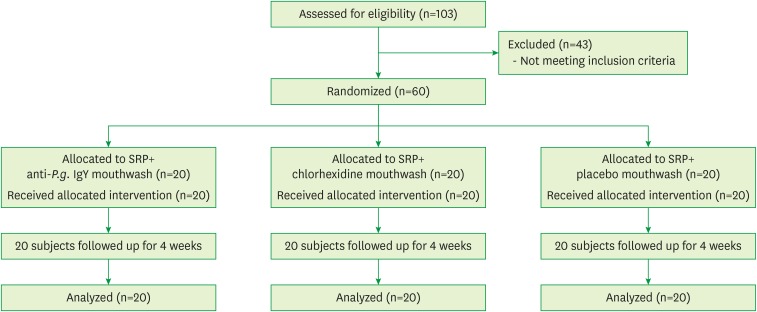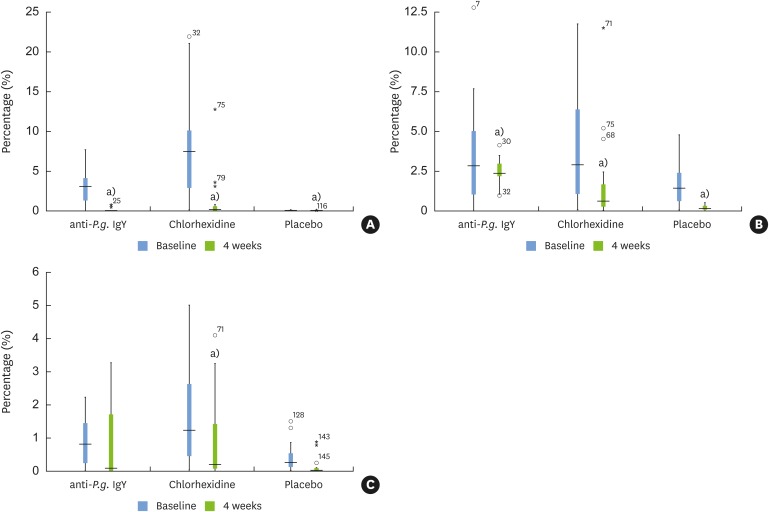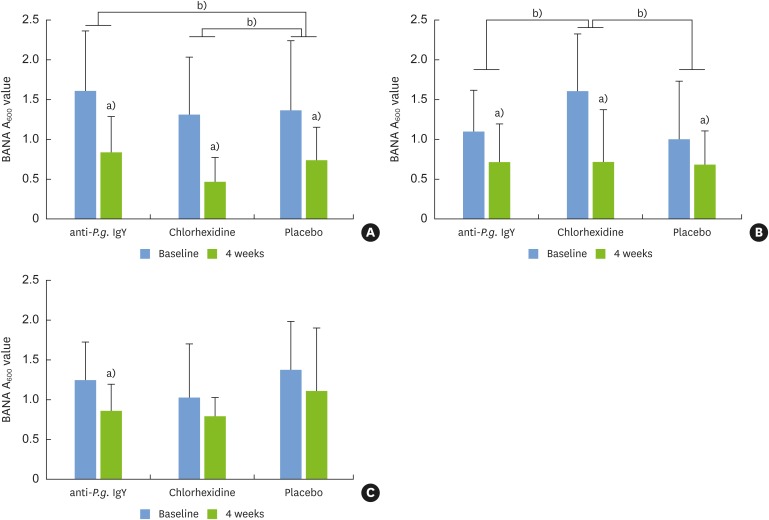J Periodontal Implant Sci.
2018 Feb;48(1):47-59. 10.5051/jpis.2018.48.1.47.
Clinical and microbiological effects of egg yolk antibody against Porphyromonas gingivalis as an adjunct in the treatment of moderate to severe chronic periodontitis: a randomized placebo-controlled clinical trial
- Affiliations
-
- 1Department of Periodontology, Stomatologic Hospital and College, Anhui Medical University, Hefei, China. 173236344@qq.com
- 2Key Laboratory of Oral Diseases Research of Anhui Province, Hefei, China.
- KMID: 2405409
- DOI: http://doi.org/10.5051/jpis.2018.48.1.47
Abstract
- PURPOSE
To evaluate the clinical and microbiological effects of the local use of egg yolk immunoglobulin against Porphyromonas gingivalis (anti-P.g. IgY) as an adjunct to scaling and root planing (SRP) in the treatment of moderate to severe chronic periodontitis.
METHODS
This was a randomized, placebo-controlled, double-blind trial involving 60 systematically healthy patients with moderate to severe chronic periodontitis. Subjects (n=20/group) were randomly assigned to receive SRP combined with subgingival irrigation of anti-P.g. IgY and anti-P.g. IgY mouthwash, subgingival irrigation of 0.2% chlorhexidine and 0.2% chlorhexidine mouthwash, or subgingival irrigation of placebo and placebo mouthwash for 4 weeks. Probing pocket depth, clinical attachment level, bleeding on probing, and the plaque index were evaluated at baseline and at 4 weeks. Subgingival plaque, gingival crevicular fluid, and saliva were simultaneously collected for microbiological analysis.
RESULTS
Our results showed that anti-P.g. IgY mouthwash was as effective as chlorhexidine at improving clinical parameters over a 4-week period. All the groups showed a significant reduction in levels of P.g. at 4 weeks. No significant difference was observed in the test group when compared to placebo regarding the reduction in the levels of P.g. Anti-P.g. IgY significantly suppressed the numbers of red complex bacteria (RCB) in subgingival plaque and saliva in comparison with placebo. No adverse effects were reported in any of the subjects.
CONCLUSIONS
Within the limitations of the study, the present investigation showed that passive immunization with anti-P.g. IgY may prove to be effective in the treatment of chronic periodontitis due to its ability to improve clinical parameters and to reduce RCB. No significant differences were found between the anti-P.g. IgY and placebo groups in the reduction of P.g.
MeSH Terms
Figure
Reference
-
1. Sanz M, van Winkelhoff AJ. Periodontal infections: understanding the complexity--consensus of the Seventh European Workshop on Periodontology. J Clin Periodontol. 2011; 38(Suppl 11):3–6. PMID: 21323698.2. Corbet EF, Leung WK. Epidemiology of periodontitis in the Asia and Oceania regions. Periodontol 2000. 2011; 56:25–64. PMID: 21501236.
Article3. Dye BA. Global periodontal disease epidemiology. Periodontol 2000. 2012; 58:10–25. PMID: 22133364.
Article4. Grenier D, Mayrand D. Periodontitis as an ecological imbalance. In : Kuramitsu HK, Ellen RP, editors. Oral bacterial ecology: the molecular basis. Wymondham: Horizon Scientific;2000. p. 275–310.5. Slots J, Ting M. Actinobacillus actinomycetemcomitans and Porphyromonas gingivalis in human periodontal disease: occurrence and treatment. Periodontol 2000. 1999; 20:82–121. PMID: 10522224.6. Holt SC, Kesavalu L, Walker S, Genco CA. Virulence factors of Porphyromonas gingivalis. Periodontol 2000. 1999; 20:168–238. PMID: 10522227.7. Bostanci N, Belibasakis GN. Porphyromonas gingivalis: an invasive and evasive opportunistic oral pathogen. FEMS Microbiol Lett. 2012; 333:1–9. PMID: 22530835.8. Slots J, Ting M. Systemic antibiotics in the treatment of periodontal disease. Periodontol 2000. 2002; 28:106–176. PMID: 12013339.
Article9. Handal T, Caugant DA, Olsen I. Antibiotic resistance in bacteria isolated from subgingival plaque in a Norwegian population with refractory marginal periodontitis. Antimicrob Agents Chemother. 2003; 47:1443–1446. PMID: 12654689.
Article10. James P, Worthington HV, Parnell C, Harding M, Lamont T, Cheung A, et al. Chlorhexidine mouthrinse as an adjunctive treatment for gingival health. Cochrane Database Syst Rev. 2017; 3:CD008676. PMID: 28362061.
Article11. Klemperer PF. Ueber natürliche immunität und ihre verwerthung für die immunisirungstherapie. Arch Exp Pathol Pharmakol. 1893; 31:356–382.
Article12. Schade R, Hlinak A. Egg yolk antibodies, state of the art and future prospects. ALTEX. 1996; 13:5–9. PMID: 11178463.13. Xu FX, Xu YP, Jin LJ, Liu H, Wang LH, You JS, et al. Effectiveness of egg yolk immunoglobulin (IgY) against periodontal disease-causing Fusobacterium nucleatum . J Appl Microbiol. 2012; 113:983–991. PMID: 22789022.14. Yokoyama K, Sugano N, Rahman AK, Oshikawa M, Ito K. Activity of anti-Porphyromonas gingivalis egg yolk antibody against gingipains in vitro. Oral Microbiol Immunol. 2007; 22:352–355. PMID: 17803634.15. Nilsson E, Larsson A, Olesen HV, Wejåker PE, Kollberg H. Good effect of IgY against Pseudomonas aeruginosa infections in cystic fibrosis patients. Pediatr Pulmonol. 2008; 43:892–899. PMID: 18680179.16. Suzuki H, Nomura S, Masaoka T, Goshima H, Kamata N, Kodama Y, et al. Effect of dietary anti Helicobacter pylori-urease immunoglobulin Y on Helicobacter pylori infection. Aliment Pharmacol Ther. 2004; 20(Suppl 1):185–192. PMID: 15298626.17. Wilhelmson M, Carlander D, Kreuger A, Kollberg H, Larsson A. Oral treatment with yolk antibodies for the prevention of C. albicans infections in chemotherapy treated children. A feasibility study. Food Agric Immunol. 2005; 16:41–45.18. Armitage GC. Development of a classification system for periodontal diseases and conditions. Ann Periodontol. 1999; 4:1–6. PMID: 10863370.
Article19. World Medical Association General Assembly. World Medical Association Declaration of Helsinki: ethical principles for medical research involving human subjects. J Int Bioethique. 2004; 15:124–129. PMID: 15835069.20. Löe H. The gingival index, the plaque index and the retention index systems. J Periodontol. 1967; 38:610–616.
Article21. Schade R, Calzado EG, Sarmiento R, Chacana PA, Porankiewicz-Asplund J, Terzolo HR. Chicken egg yolk antibodies (IgY-technology): a review of progress in production and use in research and human and veterinary medicine. Altern Lab Anim. 2005; 33:129–154. PMID: 16180988.
Article22. Sugano N. Adjunctive effects of anti-porphyromonas gingivalis egg yolk antibody with scaling and root planing: a randomized, placebo-controlled clinical trial. J Periodontol. 2009; 80:1901–1903.23. Yokoyama K, Sugano N, Shimada T, Shofiqur RA, Ibrahim ES, Isoda R, et al. Effects of egg yolk antibody against Porphyromonas gingivalis gingipains in periodontitis patients. J Oral Sci. 2007; 49:201–206. PMID: 17928726.24. Plessas A. Nonsurgical periodontal treatment: review of the evidence. Oral Health Dent Manag. 2014; 13:71–80. PMID: 24603920.25. Müller HP, Hartmann J, Flores-de-Jacoby L. Clinical alterations in relation to the morphological composition of the subgingival microflora following scaling and root planing. J Clin Periodontol. 1986; 13:825–832. PMID: 3537017.
Article26. Xu Y, Li X, Jin L, Zhen Y, Lu Y, Li S, et al. Application of chicken egg yolk immunoglobulins in the control of terrestrial and aquatic animal diseases: a review. Biotechnol Adv. 2011; 29:860–868. PMID: 21787857.
Article27. Hanes PJ, Purvis JP. Local anti-infective therapy: pharmacological agents. A systematic review. Ann Periodontol. 2003; 8:79–98. PMID: 14971250.
Article28. Socransky SS, Haffajee AD, Teles R, Wennstrom JL, Lindhe J, Bogren A, et al. Effect of periodontal therapy on the subgingival microbiota over a 2-year monitoring period. I. Overall effect and kinetics of change. J Clin Periodontol. 2013; 40:771–780. PMID: 23710672.
Article29. Shiloah J, Patters MR. Repopulation of periodontal pockets by microbial pathogens in the absence of supportive therapy. J Periodontol. 1996; 67:130–139. PMID: 8667133.
Article30. Petersilka GJ, Ehmke B, Flemmig TF. Antimicrobial effects of mechanical debridement. Periodontol 2000. 2002; 28:56–71. PMID: 12013348.
Article31. Greenstein G. Periodontal response to mechanical non-surgical therapy: a review. J Periodontol. 1992; 63:118–130. PMID: 1552465.
Article32. Socransky SS, Haffajee AD, Cugini MA, Smith C, Kent RL Jr. Microbial complexes in subgingival plaque. J Clin Periodontol. 1998; 25:134–144. PMID: 9495612.
Article33. Hajishengallis G, Lamont RJ. Beyond the red complex and into more complexity: the polymicrobial synergy and dysbiosis (PSD) model of periodontal disease etiology. Mol Oral Microbiol. 2012; 27:409–419. PMID: 23134607.
Article34. Adair JG. The Hawthorne effect: a reconsideration of the methodological artifact. J Appl Psychol. 1984; 69:334–345.
Article35. MA Coleman. Ovimmune, Inc.Oral administration of chicken yolk immunoglobulins to lower somatic cell count in the milk of lactating ruminants. United States patent. US 5,585,098. 1996. 12. 17.
- Full Text Links
- Actions
-
Cited
- CITED
-
- Close
- Share
- Similar articles
-
- Clinical and microbiological effects of the supplementary use of an erythritol powder air-polishing device in non-surgical periodontal therapy: a randomized clinical trial
- Antibody response of periodontal patients to Porphyromonas gingivalis heat shock protein
- Avidity of serum immunoglobulin G antibodies to Porphyromonas gingivalis in the elderly with chronic periodontitis
- Antibody-based Screening of Porphyromonas gingivalis Proteins Specifically Produced in Patients with Chronic Periodontitis
- T-cell epitope specificity for Porphyromonas gingivalis heat shock protein in periodontitis




